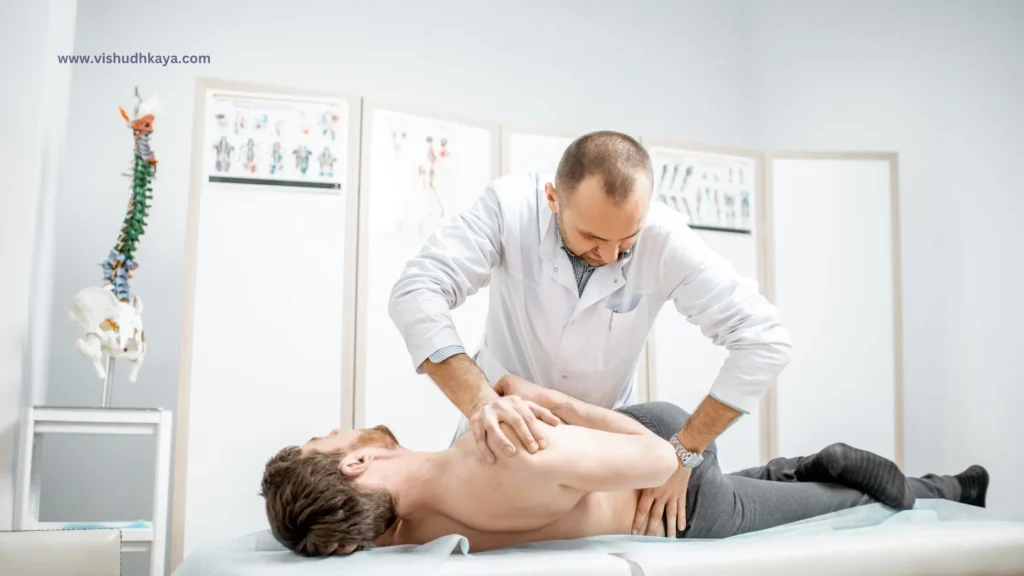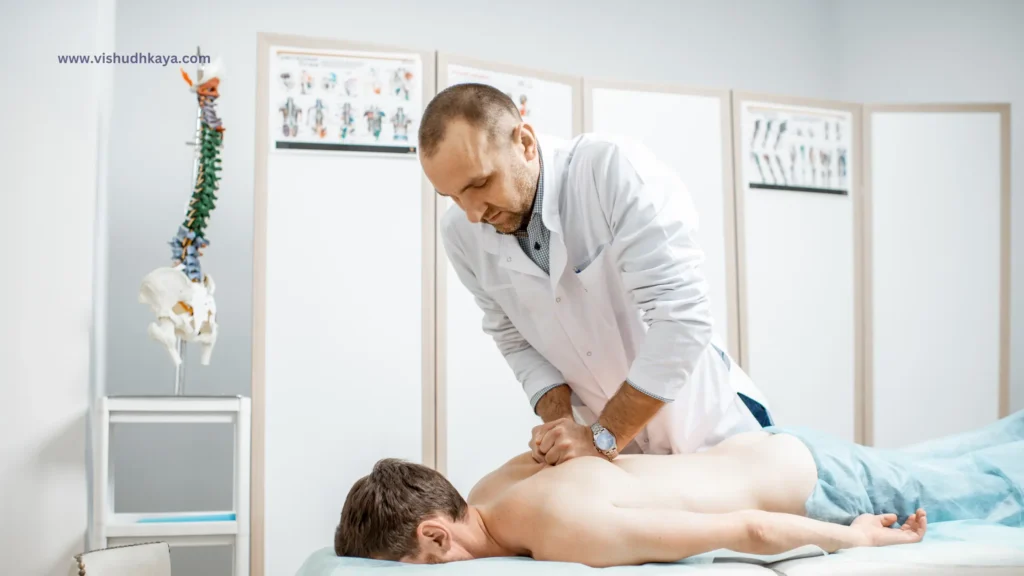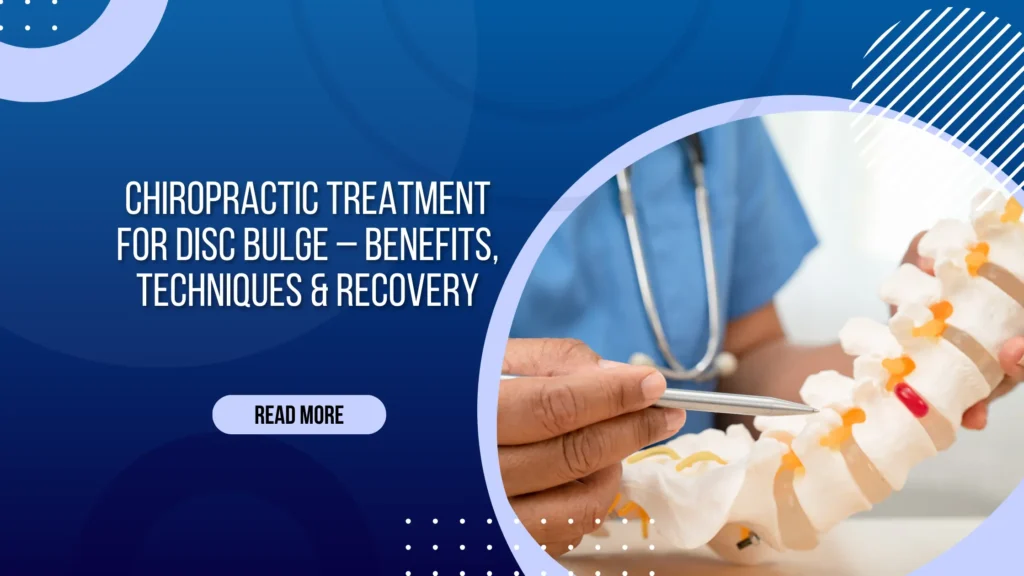Introduction
A disc bulge happens when the soft, cushion-like discs between the vertebrae shift out of their normal position, often due to aging, poor posture, repetitive strain, or injury. These discs serve as shock absorbers for the spine, allowing smooth movement. However, when they protrude, they can put pressure on nearby nerves, leading to pain and discomfort. Symptoms may include localized neck or back pain, sciatica (radiating leg pain), numbness, tingling sensations, and muscle weakness. In severe cases, a disc bulge can significantly impact daily activities and overall mobility.
Chiropractic care provides a natural, non-surgical solution by targeting the underlying cause of pain rather than simply masking the symptoms. Spinal adjustments help restore proper alignment, easing pressure on the affected disc and nerves. Techniques like spinal decompression create space for the disc to return to its original position, while soft tissue therapy reduces muscle tension and inflammation. Additionally, posture correction and therapeutic exercises strengthen the spine, improving flexibility and preventing future complications.
One of the key advantages of chiropractic treatment is that it offers effective pain relief without relying on medication or invasive procedures. Regular chiropractic sessions can enhance mobility, restore spinal function, and promote overall well-being. By supporting the body’s natural healing process, chiropractic care allows individuals to move freely and comfortably, improving their quality of life while reducing the risk of further spinal issues. Seeking early intervention and adopting a holistic approach to spinal health can lead to long-term benefits and prevent the progression of disc-related problems.
1. Understanding Disc Bulge

Causes: Poor posture, heavy lifting, ageing, injuries, or prolonged sitting
Several factors contribute to the development of a disc bulge, often due to excess strain or degeneration of the spinal discs over time. The most common causes include:
- Poor Posture – Slouching or improper spinal alignment increases stress on the discs, gradually leading to bulging. Sitting for long hours with inadequate back support can accelerate disc wear and tear.
- Heavy Lifting – Incorrect lifting techniques, such as bending at the waist instead of the knees, put excessive pressure on the spine, increasing the risk of disc displacement.
- Ageing – As the body ages, spinal discs lose water content and elasticity, making them less resilient and more prone to bulging. Degenerative disc disease is a common cause of disc bulges in older adults.
- Injuries – Sudden trauma, falls, or accidents can displace discs, leading to a bulge. Repetitive strain from physical activities, such as sports or manual labour, can also contribute to disc damage over time.
- Prolonged Sitting – Sitting for extended periods, especially with poor ergonomics, reduces spinal mobility and increases pressure on the discs, leading to structural changes and potential bulging.
Symptoms: Back pain, leg pain (sciatica), tingling, weakness, and stiffness.
The severity and location of the bulge influence the symptoms, which may vary from mild discomfort to significant nerve compression. Common symptoms include:
- Back Pain – Aching, dull, or sharp pain localized in the upper or lower back, depending on the affected disc.
- Leg Pain (Sciatica) – A bulging disc in the lower spine can press on the sciatic nerve, causing radiating pain down the leg, often accompanied by numbness or burning sensations.
- Tingling or Numbness – Compression of spinal nerves can lead to a sensation of “pins and needles” or numbness in the hands, arms, legs, or feet.
- Weakness – Nerve compression from a disc bulge may lead to reduced muscle strength, making activities such as walking, lifting objects, or standing for long periods more difficult.
- Stiffness – Limited range of motion and difficulty bending, twisting, or performing routine movements due to spinal discomfort.
Difference between Disc Bulge & Herniated Disc: A bulge is a mild protrusion, while herniation involves disc rupture.
Although both conditions affect the spinal discs, they differ in severity:
- Disc Bulge: A bulging disc occurs when the outer layer of the disc slightly protrudes outward but remains intact. While it may cause mild to moderate symptoms, it does not involve a rupture.
- Herniated Disc: A herniated disc is more severe, as it involves a tear in the disc’s outer layer, allowing the inner gel-like material to leak out. This can lead to significant nerve irritation, inflammation, and more intense pain.
Herniated discs typically cause more severe symptoms than disc bulges and may require more aggressive treatment. In contrast, a disc bulge can often be managed with non-invasive treatments such as chiropractic care, physical therapy, and lifestyle modifications.
2. How Chiropractic Care Helps in Disc Bulge Treatment

Chiropractic care offers a non-invasive and drug-free solution for managing disc bulges by addressing spinal misalignments, reducing nerve pressure, and improving mobility. By utilizing specific chiropractic techniques, patients can experience pain relief and long-term spinal health benefits.
Spinal Adjustments
Chiropractors perform controlled spinal adjustments to correct misalignments in the vertebrae. This process helps restore proper spinal alignment, reducing nerve compression and alleviating pain associated with a disc bulge.
Decompression Therapy
Decompression therapy involves gently stretching the spine to create space between the vertebrae. This relieves pressure on the affected disc, allowing it to retract slightly and reducing nerve irritation, which can help decrease pain and inflammation.
Postural Corrections
Poor posture can contribute to spinal misalignment and worsen disc issues. Chiropractors provide guidance on maintaining a neutral spine through ergonomic adjustments, proper sitting and standing techniques, and corrective exercises to prevent further damage.
Soft Tissue Therapy
Soft tissue therapy focuses on relaxing tight muscles and reducing inflammation around the affected area. Techniques such as massage and myofascial release improve circulation, relieve muscle tension, and enhance overall mobility, supporting spinal function.
Rehabilitation Exercises
To strengthen the spine and prevent future issues, chiropractors recommend specific rehabilitation exercises. These exercises focus on improving core stability, flexibility, and overall spinal strength, ensuring better long-term support for the affected area.
By combining these chiropractic techniques, patients can effectively manage disc bulges, experience pain relief, and improve their spinal health without resorting to medications or surgery.
3. Common Chiropractic Techniques for Disc Bulge

Flexion-Distraction Technique
This gentle spinal stretching method helps reduce pressure on the affected disc by creating space between the vertebrae. It involves slow, controlled movements that improve spinal mobility, decrease nerve compression, and enhance circulation to promote healing.
Spinal Manipulation
Spinal manipulation, also known as chiropractic adjustment, focuses on realigning the vertebrae to restore proper spinal function. This technique helps alleviate pain, reduce nerve interference, and improve flexibility, allowing better overall movement.
Pelvic Blocking Techniques
This method uses specially designed padded wedges placed under the pelvis to encourage natural spinal realignment. By reducing nerve irritation and improving disc positioning, pelvic blocking helps relieve discomfort associated with disc bulges.
Myofascial Release Therapy
Tight muscles and fascia around the affected area can contribute to pain and restricted mobility. Myofascial release therapy targets these tight tissues, helping to improve flexibility, reduce muscle tension, and support the spine’s healing process.
Postural Training & Ergonomic Guidance
Poor posture and improper ergonomics can worsen spinal issues over time. Chiropractors provide postural training and ergonomic advice to help maintain a neutral spine, prevent unnecessary strain, and reduce the risk of future disc problems.
By using these chiropractic techniques, patients with disc bulges can experience effective pain relief, enhanced mobility, and better long-term spinal health.
4. Recovery Tips after Chiropractic Treatment
Recovering after chiropractic treatment requires adopting healthy habits that promote healing, maintain spinal alignment, and prevent future complications. Chiropractic adjustments help restore proper spinal function, but maintaining these benefits depends on lifestyle choices. Following these recovery tips will enhance long-term spinal health, reduce discomfort, and improve overall well-being.

Maintain Proper Posture
Posture plays a crucial role in spinal health. Ensuring a neutral spine while sitting, standing, and engaging in daily activities reduces unnecessary stress on the back and spinal discs. Poor posture, such as slouching or hunching, can counteract the benefits of chiropractic adjustments and lead to recurrent pain.
To maintain good posture:
- While Sitting: Keep your feet flat on the ground, your back straight, and your shoulders relaxed. Use a chair with lumbar support to maintain the natural curve of your lower back.
- While Standing: Distribute your weight evenly on both feet and keep your shoulders aligned with your hips. Avoid leaning to one side or standing with a slouched posture.
- During Daily Activities: Be mindful of your posture when walking, using electronic devices, or performing tasks that require bending or lifting. Proper spinal alignment reduces strain on muscles and joints, helping to prevent further discomfort.
Follow a Strengthening Routine
Strengthening the muscles surrounding the spine plays a vital role in maintaining spinal health. A strong core provides better support to the spine, reduces the risk of injury, and enhances overall posture. Chiropractors often recommend targeted exercises to reinforce spinal stability.
- Core Stability Exercises: Strengthening the abdominal, lower back, and pelvic muscles helps stabilize the spine and distribute pressure evenly. Exercises like planks, bridges, and controlled abdominal workouts improve core strength.
- Stretching & Flexibility: Gentle stretching helps maintain spinal flexibility and prevents stiffness. Stretching the hamstrings, hip flexors, and lower back muscles can alleviate tension and improve range of motion.
- Low-Impact Workouts: Yoga and Pilates are excellent for building core strength while promoting relaxation and flexibility. These exercises also improve balance, reducing the likelihood of injuries.
A well-conditioned core minimizes spinal stress, making it easier to maintain proper posture and preventing strain on the lower back.
Avoid Heavy Lifting
Lifting heavy objects improperly can place excessive pressure on the spine, potentially worsening disc conditions or reversing the effects of chiropractic treatment. If lifting is unavoidable, it is important to use correct techniques to protect the spine.
Safe lifting techniques include:
- Bending at the knees instead of the waist to engage leg muscles rather than the lower back.
- Holding objects close to the body to maintain balance and reduce strain on the spine.
- Avoiding twisting motions while lifting, as this can increase the risk of injury.
Whenever possible, avoid heavy lifting altogether, especially during the early stages of recovery, to prevent unnecessary stress on the lower back.
Stay Active
Engaging in regular physical activity is essential for maintaining spinal health and promoting recovery after chiropractic treatment. Movement helps increase blood circulation, which delivers oxygen and nutrients to spinal tissues, aiding in healing.
Recommended activities include:
- Walking: A low-impact exercise that helps maintain spinal mobility and improves posture. A short daily walk can prevent stiffness and support recovery.
- Swimming: Provides gentle resistance that strengthens muscles while reducing stress on joints and the spine. The buoyancy of water allows for movement without added pressure on the back.
- Gentle Stretching: Incorporating daily stretching routines improves flexibility and prevents tight muscles from pulling the spine out of alignment.
- Chiropractor-Recommended Exercises: Specific movements prescribed by your chiropractor can help enhance the benefits of treatment and prevent the recurrence of spinal issues.
Remaining active without overexerting yourself is key to a smooth recovery. Avoid high-impact activities that may strain the spine, such as running or heavy weightlifting, until advised otherwise by your chiropractor.
Hydration & Nutrition
Proper hydration and a nutrient-rich diet play a vital role in spinal health and recovery. Spinal discs are composed largely of water, and dehydration can cause them to lose their elasticity and shock-absorbing properties, increasing the risk of pain and stiffness.
Hydration Tips:
- Drink plenty of water throughout the day to keep spinal discs hydrated.
- Reduce intake of caffeinated and sugary drinks, as they can contribute to dehydration.
- Consume foods with high water content, such as fruits and vegetables, to support hydration.
Nutritional Guidelines for Spinal Health:
- Calcium & Vitamin D: Essential for bone health and maintaining strong vertebrae. Sources include dairy products, leafy greens, and fortified foods.
- Omega-3 Fatty Acids: Help reduce inflammation and support spinal tissue healing. Found in fish, flaxseeds, and walnuts.
- Protein: Aids in tissue repair and muscle recovery. Lean meats, beans, and nuts are excellent sources.
- Magnesium: Supports muscle relaxation and prevents cramps. Present in nuts, seeds, and whole grains.
A balanced diet rich in essential nutrients helps repair damaged tissues, reduces inflammation, and supports overall spinal health, enhancing the effectiveness of chiropractic treatment.
5. Schedule Your Chiropractic Treatment at Vishudh Kaya Pain Relief & Multi-Specialty Clinic
At Vishudh Kaya Pain Relief & Multi-Specialty Clinic, we provide expert chiropractic care to help manage disc bulge discomfort naturally. Our treatments aim to reduce pain, restore mobility, and enhance long-term spinal health.
✅ Customized Treatment Plans – Individualized chiropractic care designed to meet your specific recovery needs.
✅ Skilled Chiropractors – Our professionals specialize in advanced spinal adjustment techniques to ensure effective and safe treatment.
✅ Non-Invasive & Drug-Free Therapy – A holistic approach focused on natural healing and long-lasting relief without surgery or medication.
📅 Book Your Appointment Today!
📍 Visit us in Kharar | 📞 Call/WhatsApp: 7678135151
Start your journey to a healthier spine—schedule your consultation now!
FAQs: Chiropractic Care & Bulging Discs
1. Is chiropractic good for disc bulge?
Yes, chiropractic care can help manage symptoms of a bulging disc, such as pain, stiffness, and nerve irritation. Chiropractors use gentle spinal adjustments, mobilization, and soft tissue therapy to reduce pressure on the affected disc and improve spinal alignment. However, it’s not a “cure” for the bulge itself. Success depends on the severity of the injury and individual response. Always ensure a proper diagnosis (via MRI or CT scan) before starting treatment, as aggressive manipulation may worsen certain cases.
2. How long does it take for a chiropractor to fix a bulging disc?
There’s no universal timeline, as healing depends on:
Severity: Mild bulges may improve in 4–6 weeks with consistent care.
Chronicity: Long-standing issues can take 3–6 months to show progress.
Lifestyle: Posture, exercise, and avoiding reinjury are critical.
Many patients report reduced pain within 2–4 weeks, but disc healing is a slow process (often 6–12 months). Chiropractic care focuses on symptom relief and functional improvement, not “fixing” the disc overnight.
3. Can chiropractors fix discs?
Chiropractors cannot “fix” or reverse a bulging disc, as discs don’t snap back into place like bones. However, they can:
Reduce inflammation and muscle tension around the disc.
Improve joint mobility to relieve nerve compression.
Guide rehab exercises to strengthen supportive muscles.
The body often reabsorbs minor disc bulges over time. Chiropractic care supports this natural healing process by addressing contributing factors (e.g., misalignment, poor movement patterns).
4. What is the best therapy for a bulging disc?
A combination of approaches is usually most effective:
Physical therapy: Core strengthening, stretching, and posture training.
Chiropractic care: Spinal adjustments and decompression therapy.
Medical treatments: Pain relievers, epidural steroid injections, or surgery (in severe cases).
Lifestyle changes: Weight management, ergonomic adjustments, and low-impact exercise (e.g., swimming).
Studies suggest physical therapy paired with patient education has the strongest evidence for long-term recovery, but individualized plans are key.
5. Is physio or chiro better for bulging discs?
Both have unique roles:
Physiotherapy focuses on rehabilitating the disc through targeted exercises, core stability work, and education to prevent recurrence.
Chiropractic care prioritizes pain relief and restoring spinal mobility through adjustments.
For best results, many patients combine the two: chiropractic for acute pain relief and physio for long-term strengthening. Severe cases (e.g., with numbness/weakness) may require a multidisciplinary approach, including a neurologist or orthopaedic specialist.


